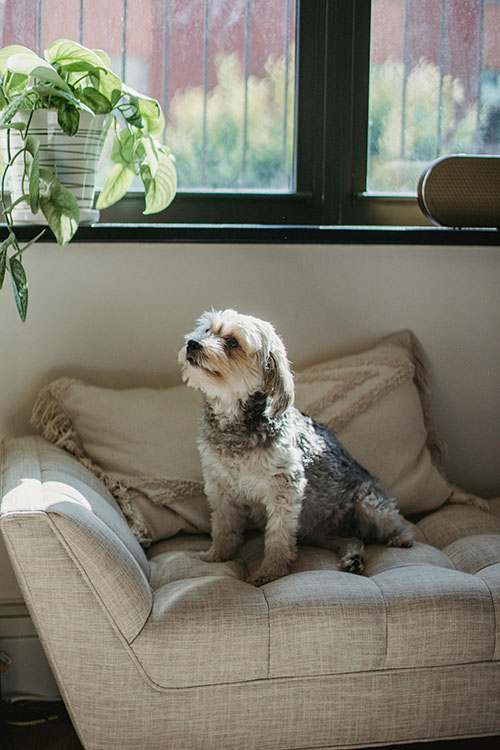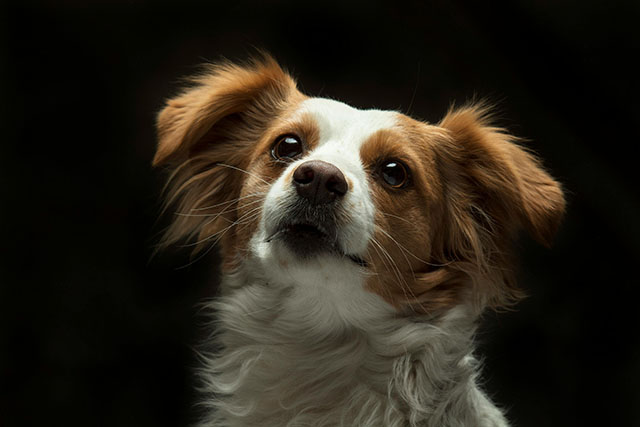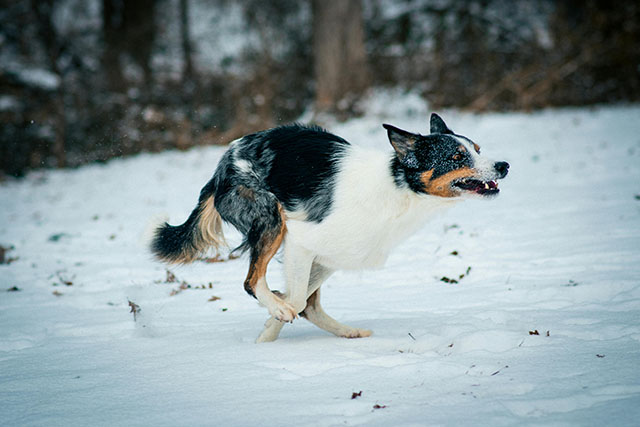As dog owners, we have all experienced the frustration of our furry friends constantly licking the couch. It may seem like a harmless behavior at first, but it can quickly become a nuisance and even cause damage to your furniture.
But why do dogs lick the couch? Is it just a bad habit, or is there a deeper reason for this behavior? Continue reading to discover more.
Why Does My Dog Keep Licking the Sofa?
There are several reasons why your dog may be consistently licking the sofa, ranging from simple to more complex behavioral and health-related issues:
Boredom
Dogs often lick objects around them when they’re bored or lack sufficient physical and mental stimulation.
Anxiety or Stress
Just like humans, dogs can experience anxiety and stress, which they might try to alleviate by engaging in repetitive behaviors such as licking.
The Taste
Your sofa might have traces of food, skin cells, or other scents that appeal to your dog and motivate them to lick it.
Health Issues
Compulsive licking can sometimes indicate underlying health problems, such as nutritional deficiencies or gastrointestinal issues.
Comfort and Habit
For some dogs, licking is a comforting behavior or a habit they’ve developed over time, possibly stemming from the soothing effect licking has, similar to how puppies are groomed by their mothers.
Understanding the root cause of this behavior is crucial for addressing it effectively and ensuring your pet’s well-being, as well as the longevity of your furniture.
Should I Let My Dog Lick Furniture?
Allowing your dog to lick furniture is not recommended for several reasons. First, it can lead to the deterioration of your furniture’s finish and overall appearance. Second, saliva can stain and damage various materials, potentially leading to costly repairs or replacements.
Secondly, this behavior can reinforce negative habits, making it more challenging to manage over time. It’s also important to consider that furniture could contain harmful bacteria or cleaning chemicals that are unsafe for your dog to ingest.
Instead, focus on addressing the underlying cause of the licking through increased exercise, mental stimulation, and, if necessary, consulting with a veterinarian or an animal behaviorist.
When Should I Be Concerned About My Dog Licking?
While occasional licking is normal behavior for dogs, there are instances when it could be a sign of a more serious concern. It’s important to observe your dog’s behavior and recognize when to seek professional help. Here are some key indicators that the licking behavior might be more than just a bad habit:
- Excessive Licking: If your dog is licking the same area relentlessly or for extended periods, this could indicate an underlying issue.
- Licking Causing Harm: Licking that leads to hair loss, skin irritation, or wounds is a clear sign that something is amiss.
- Behavior Change: Your dog might signal discomfort or distress by suddenly increasing its licking or shifting behavioral patterns.
- Health Symptoms: If the licking is accompanied by other symptoms like vomiting, diarrhea, lethargy, or loss of appetite, these could be indicative of a health problem requiring immediate attention.
In such cases, consulting a veterinarian to rule out any medical conditions is crucial. It’s always better to err on the side of caution and get a professional opinion to ensure the health and happiness of your beloved pet.
How Do I Get My Dog to Stop Licking Furniture and Carpet?
To discourage your dog from licking the furniture and carpet, consider implementing the following steps:- Provide Adequate Physical Exercise: Dogs need regular physical activity to burn off energy. You can incorporate the Trixie Dog Agility Hurdle Cone Set in your dog’s daily routine to ensure your dog gets enough exercise appropriate for their age, breed, and health status.
- Increase Mental Stimulation: Use puzzle toys like Outward Hound Nina Ottosson Dog Brick Puzzle to keep your dog mentally stimulated. This can help prevent boredom, a common cause of repetitive licking.
- Implement Consistent Training: Use positive reinforcement techniques to train your dog. When they lick the furniture, redirect their attention to a more appropriate activity or toy, and reward them by giving Pet Botanics Training Rewards Treats for choosing the alternative behavior.
- Maintain a Routine: Dogs thrive on routine. Having a predictable schedule for walks, playtime, and meals can reduce anxiety and stress, minimizing stress-related licking.
- Address Anxiety and Stress: If your dog’s licking is anxiety-driven, consider techniques like desensitization to help them feel more secure. Consultation with an animal behaviorist or a veterinarian might be necessary for severe cases.
- Check for Health Issues: Since excessive licking can sometimes signal health problems, a veterinary checkup is essential to rule out any underlying medical issues.
- Use Safe Deterrents: For some dogs, applying safe, bitter-tasting deterrents specifically designed for pets onto furniture can discourage licking. Always ensure that any product used is safe for animals.
- Provide Alternatives: Give your dog chew toys, bones, or licking mats to occupy their mouths and provide a soothing outlet for their licking urges.
- Observe and Understand: Pay attention to when and why your dog licks. Understanding the trigger can help you address the root cause more effectively.
How Do I Know If My Dog Has Pica?
Pica is a condition where dogs eat objects that are not food, such as fabric, paper, rocks, or plastic. Recognizing the signs of pica is crucial for preventing potential health issues that can arise from ingesting non-food items. Here are several indicators that your dog might have pica:- Unusual Eating Habits: If your dog shows a persistent interest in eating non-food items regularly, this is the most direct sign of pica.
- Vomiting or Diarrhea: Ingesting non-food items can cause gastrointestinal distress, leading to vomiting or diarrhea.
- Lethargy or Lack of Appetite: A dog suffering from an obstruction due to eating foreign objects may become lethargic or show less interest in food.
- Changes in Stool: You may notice foreign materials in your dog’s stool or changes in its consistency, indicating an inability to digest certain items.
- Behavioral Changes: A sudden increase in obsessive behaviors, including focused interest in non-edible objects, can also be a sign of pica.
Securing Your Dog’s Health and Happiness
Understanding and addressing the causes behind your dog’s licking, whether it’s a harmless habit or an indicator of pica or other health concerns, is crucial for their well-being. By ensuring they receive adequate exercise, mental stimulation, and appropriate medical care, you can mitigate these behaviors and foster a healthier, happier life for your furry friend. Early intervention and consistent, positive reinforcement are key to managing and correcting unwanted licking or eating behaviors. Your vigilance and proactive approach can make all the difference in protecting your dog from potential health risks and strengthening the bond you share.Jessica is a veterinary medicine student who is passionate about animals. Living with her cherished dog, Milo, deepens her understanding of the human-animal connection, enhancing her empathy as a future veterinarian.
Jessica’s concise articles reflect her dedication to improving the lives of animals and those who care for them, making her an inspiring figure in the pet care field.







